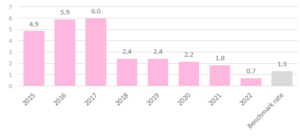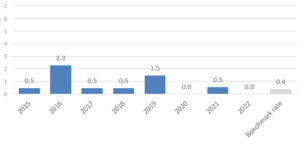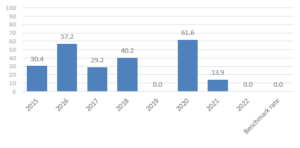Pressure injury rate
How does Cabrini’s pressure injury rate compare?
Overall pressure* injury rate

What does this mean?
A pressure injury is an area of skin and/or underlying tissue that has been damaged due to constant pressure. Pressure injuries usually occur over a bony prominence and can develop over a very short time. People at most risk are those who are frail, elderly, have a long term illness or a condition that that restricts their mobility. Pressure injuries are graded to four levels, from Grade I (skin discolouration) through to Grade IV – death or damage to the skin and underlying structures, such as tendon, joint or bone. * This report counts Grade III and IV which developed after admission.
What are we doing to further reduce pressure injuries?
Staff will monitor and assess your risk every day. A range of measures can be put in place to help prevent pressure injuries. For patients who are unable to move independently, your nursing staff will reposition you on a regular basis.
What can you do?
If your medical condition permits, the key to avoiding pressure injuries is to move early and often. Avoid sitting or lying in the one position for a prolonged time. Please inform your nurse if you have any sore spots such as on your backside or heels as this can be an early sign of a pressure injury. Patients, their families, and carers have an important role to play in preventing and managing pressure injuries.
To learn about the prevention and management of pressure injuries click here.
Cabrini sites’ pressure injury statistics
*A pressure injury is a localised injury to the skin and/or underlying tissue, usually over a bony prominence, as a result of pressure, or pressure in combination with shear and/or friction. A lower pressure injury rate is better.
Malvern pressure* injury rate

Brighton pressure* injury rate

Prahran pressure* injury rate
